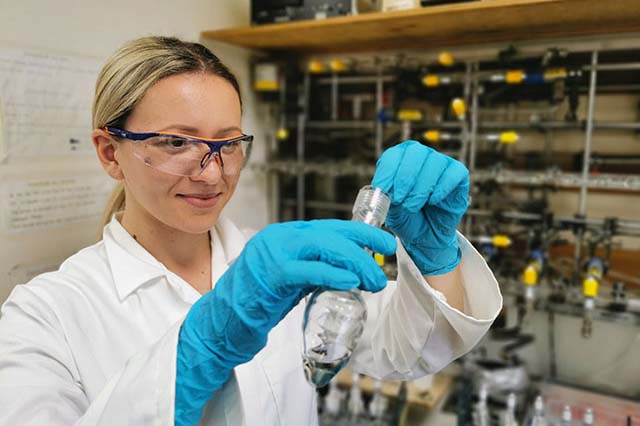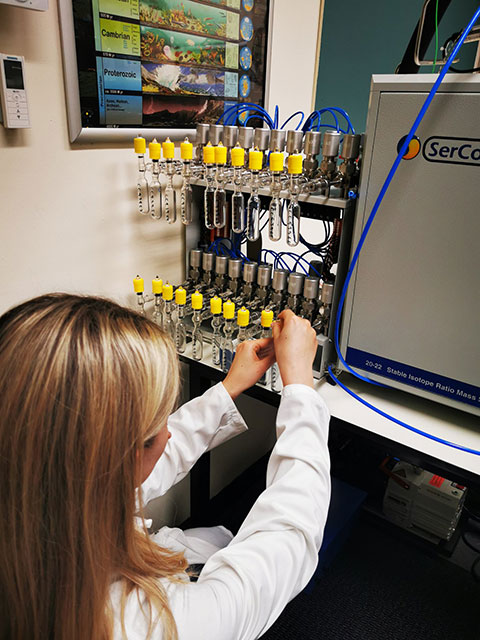Training in stable isotope analysis as a PhD student from Croatia
Recently, Ivona Ivkić Filipović visited BGS to undertake a placement at the Stable Isotope Facility. Here, she tells us a little about her experience and how it will contribute to her PhD research.
20/07/2022 By BGS Press
In May 2022, I had a training placement as a PhD student in the Stable Isotope Facility of the British Geological Survey in Keyworth, Nottingham. Since stable isotope laboratories are limited in my country (Croatia), I had applied for a scholarship from the British Scholarship Trust aimed at PhD students who want to gain research experience in the UK. The training focused on the stable isotope analysis of lake carbonates and ostracod microfossils from karst lakes in Dalmatia (Croatia) to reconstruct palaeoenvironmental and palaeoclimate changes during the Holocene.
Lakes are water bodies sensitive to environmental change governed by climate and human influences. These changes are often well-preserved in lake sediments, which we can drill into to retrieve the lake sediment cores (think of a tube going through a layered cake). The cores, which record time from the youngest sediments at the top, are usually analyzed for lots of different components including their chemistry, sedimentolgy, and micropalaeontology. In these Croatian lakes the stable isotope analysis, which I undertook at BGS, and the microfossil assemblages are particularly useful and will tell us about both past temperatures and rainfall.
The training I undertook included sample preparation of small ostracod shells and other lake carbonate samples. I learnt how to analyse these materials for carbon and oxygen isotopes by isotope ratio mass spectrometry. Preparation of ostracod shells is challenging since their shells are extremely small and can easily break during the cleaning process, resulting in a loss of material for analysis. I also got experience of methods to remove subborn organic materials using a plasma ashing method, whereby a plasma source and oxygen oxidise organic materials on the surface of the shells. The plasma ashing results in nice, clean, and ready to go material for analysis using mass spectrometry.
Lake sediments are comprised of many different forms of carbonate. I wanted to analyse material that precipitated in the lake (the endogenic component) so I had to remove all other material. This was done by sieving (shells, sand etc) and bleaching (organics). To ensure that the samples are mostly endogenic I was able to get experience of the scanning electron microscope, where I could check the composition of the smallest of fragments prior to analysis.
Besides the sample preparation, I had a chance to see how large laboratories, like the Stable Isotope Facility, operate. The isotope laboratories have eleven gas-source isotope ratio mass spectrometers that are supported by a whole array of preparation laboratories. They are one of the bigger isotope facilities in the UK.

CO2 is extracted into glass vials, which is then used as a source for the isotope ratio mass spectrometery analysis.
Overall, I can say that my visit to BGS was very positive and productive and I took most of my data home with me! I had the opportunity to work with experienced scientists including Jack Lacey, Kotryna Savickaite, Harvey Pickard, and Chloe Walker-Trivett: I thank them for their kindness and support during my stay. Special thanks to Prof Melanie Leng for hosting me as a PhD student and for our many talks regarding data interpretation. I would also like to thank my PhD supervisor Nikolina Ilijanić and Croatian Geological Survey for the opportunity to visit the BGS, for providing the lake sediment samples and for financial support to carry out the analysis.
I can only encourage other students from the UK and other countries to apply for scholarships at BGS, especially students with limited access to sophisticated laboratories like myself. The experience and knowledge gained at the BGS improved my understanding of stable isotope analysis and palaeolimnology, which will significantly contribute to my PhD thesis.
About the author
Ivona Ivkić Filipović is currently a PhD student at the Croatan Geological Survey in Zagreb, researching in environmental change records from Croatian lakes.


